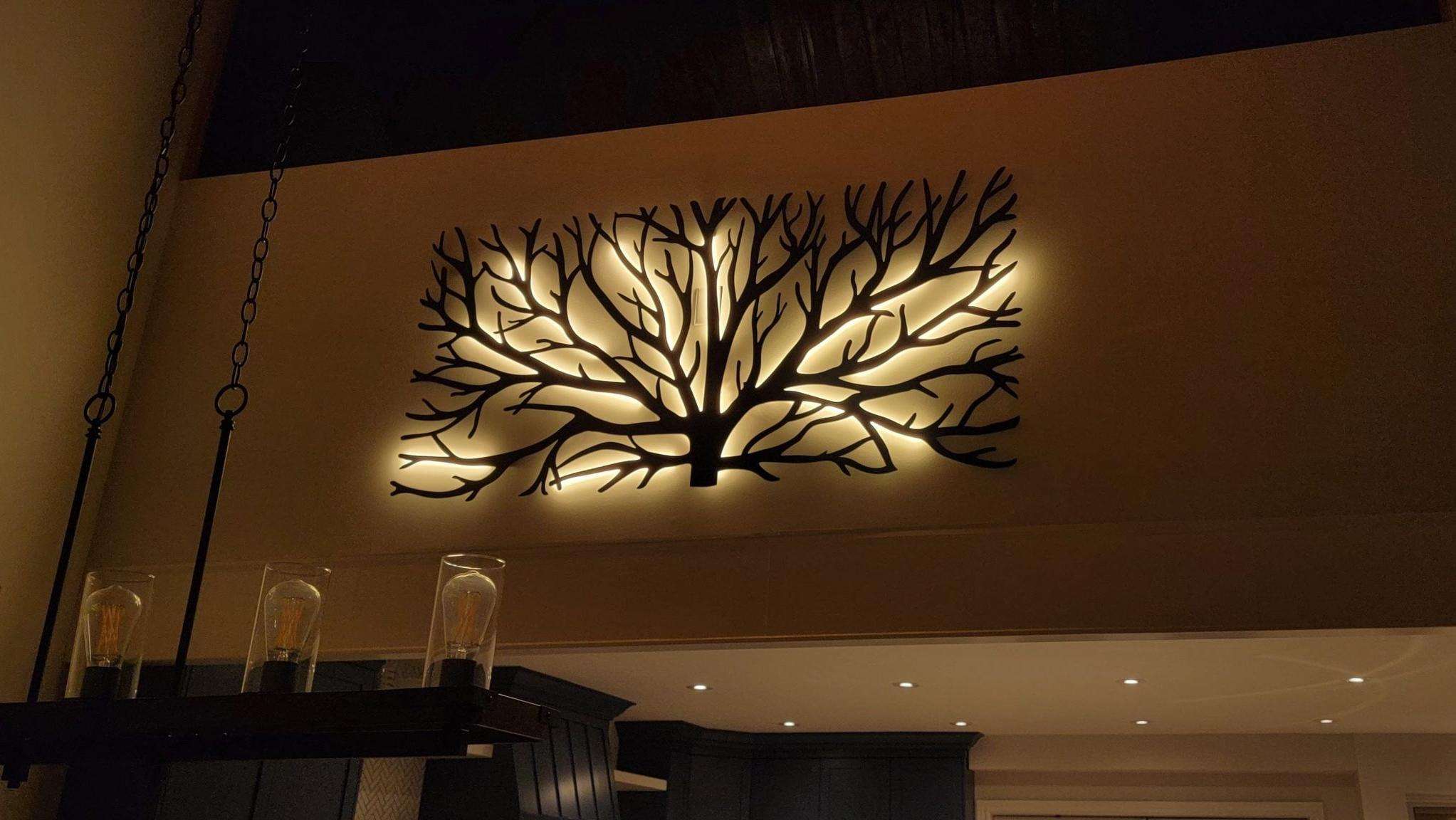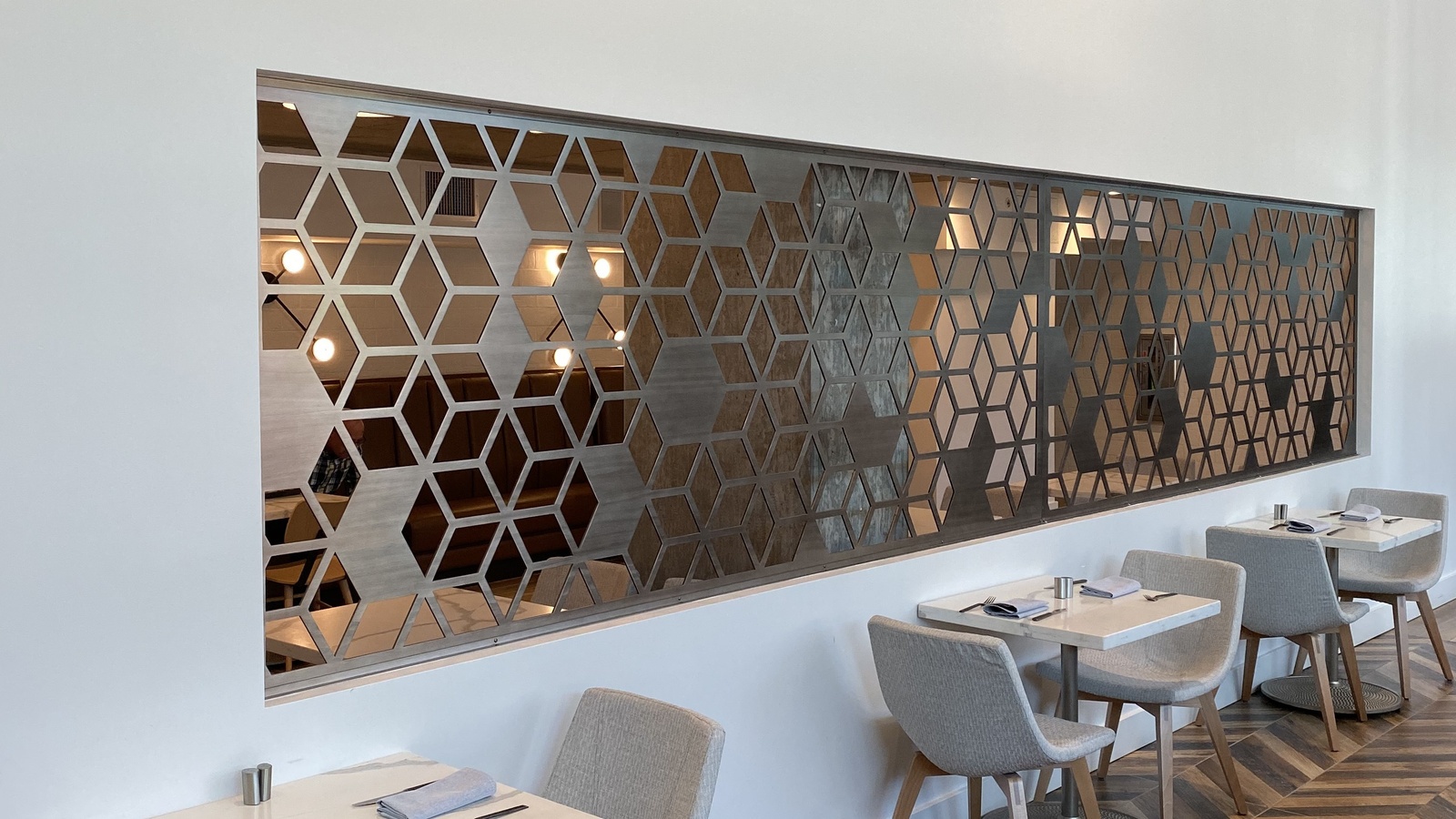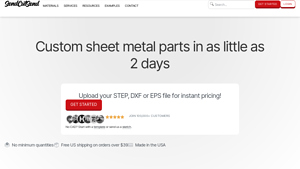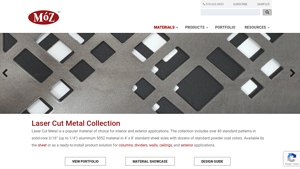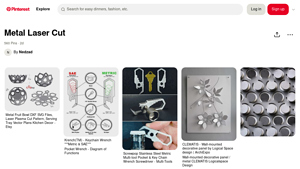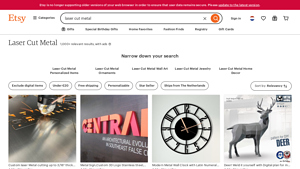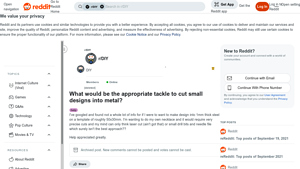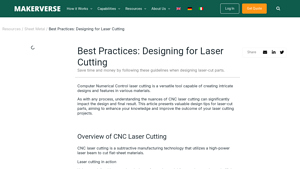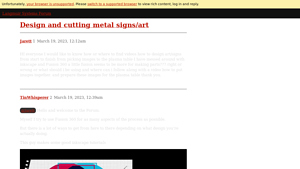Metal Cutting Design Guide: Type, Cost, Top List…
Introduction: Navigating the Global Market for metal cutting design
Navigating the complex landscape of metal cutting design presents a significant challenge for international B2B buyers, particularly those sourcing from diverse regions such as Africa, South America, the Middle East, and Europe. Understanding the nuances of metal cutting—ranging from laser cutting to CNC machining—can be daunting, especially when considering factors like material selection, application specificity, and supplier reliability. This guide aims to demystify the metal cutting design process by offering a comprehensive overview that covers various cutting techniques, their applications, and critical insights into supplier vetting and cost analysis.
In an increasingly globalized market, making informed purchasing decisions is paramount for businesses looking to optimize their production processes and maintain competitive advantage. This guide empowers B2B buyers by providing actionable insights into the latest trends, best practices, and essential criteria for selecting the right metal cutting suppliers. From understanding the benefits of different materials to evaluating turnaround times and pricing structures, our aim is to equip you with the knowledge necessary to navigate the intricacies of metal cutting design effectively. Whether you are based in Nigeria, Germany, or any other strategic market, this resource will serve as your go-to reference for enhancing procurement strategies and ensuring high-quality outcomes in your projects.
Understanding metal cutting design Types and Variations
| Type Name | Key Distinguishing Features | Primary B2B Applications | Brief Pros & Cons for Buyers |
|---|---|---|---|
| Laser Cutting | High precision, minimal thermal distortion, versatile | Aerospace, automotive, electronics | Pros: Excellent for intricate designs; fast turnarounds. Cons: Higher initial costs for setup. |
| Waterjet Cutting | No heat-affected zone, can cut thick materials | Construction, shipbuilding, metal art | Pros: Ideal for sensitive materials; versatile in thickness. Cons: Slower than laser cutting for thin sheets. |
| CNC Machining | Subtractive process, complex geometries possible | Aerospace, medical devices, custom parts | Pros: High accuracy; suitable for a variety of materials. Cons: Longer lead times; generally higher costs. |
| Plasma Cutting | Fast cutting speeds, effective for thicker metals | Heavy equipment, fabrication, automotive | Pros: Cost-effective for thick materials; quick setup. Cons: Less precision compared to laser cutting. |
| Sheet Metal Fabrication | Involves multiple processes like bending and welding | HVAC, automotive, custom enclosures | Pros: Comprehensive; allows for complex assemblies. Cons: More time-consuming; requires skilled labor. |
What Are the Characteristics of Laser Cutting in Metal Design?
Laser cutting is renowned for its precision and ability to create intricate designs with minimal thermal distortion. This method utilizes a focused laser beam to melt or vaporize the material, making it ideal for applications requiring high accuracy, such as aerospace and electronics. When purchasing laser-cut parts, businesses should consider the setup costs and the lead time, which can be mitigated by choosing suppliers with advanced technology and quick turnaround capabilities.
How Does Waterjet Cutting Compare to Other Methods?
Waterjet cutting employs a high-pressure jet of water mixed with abrasive particles to cut through materials. This method is particularly advantageous for sensitive materials like plastics and composites, as it does not introduce heat that could alter their properties. Businesses in construction and shipbuilding often prefer this method due to its versatility in thickness and material types. Buyers should evaluate the trade-off between speed and precision, as waterjet cutting can be slower for thinner materials.
Why Choose CNC Machining for Complex Geometries?
CNC machining is a subtractive manufacturing process that excels at producing complex geometries with high accuracy. This technique is widely used in industries such as aerospace and medical devices, where precision is paramount. B2B buyers should assess their project requirements, including material type and complexity, as CNC machining typically involves longer lead times and higher costs compared to other methods. However, the resulting parts often meet stringent tolerances.
What Are the Benefits of Plasma Cutting for Thicker Metals?
Plasma cutting is a fast and efficient method for cutting thicker metals, making it a popular choice in heavy equipment and automotive industries. This technique uses ionized gas to melt the material, allowing for quick setups and cost-effective production. While plasma cutting is generally less precise than laser cutting, it is suitable for applications where speed is prioritized. Buyers should weigh the need for precision against the material thickness and production timelines.
How Does Sheet Metal Fabrication Facilitate Comprehensive Solutions?
Sheet metal fabrication encompasses various processes, including cutting, bending, and welding, to create complex assemblies. This method is essential in industries like HVAC and automotive, where custom enclosures and components are required. When considering sheet metal fabrication, businesses should evaluate the skill level of the workforce and the time required for assembly. While it can be more labor-intensive, the ability to produce comprehensive solutions makes it invaluable for custom projects.
Key Industrial Applications of metal cutting design
| Industry/Sector | Specific Application of metal cutting design | Value/Benefit for the Business | Key Sourcing Considerations for this Application |
|---|---|---|---|
| Automotive | Custom components for vehicle assembly | Enhanced production efficiency and reduced lead times | Quality certification, material specifications, and delivery timelines |
| Aerospace | Precision parts for aircraft manufacturing | High safety standards and compliance with regulations | ISO certifications, traceability of materials, and design flexibility |
| Construction | Structural steel fabrication for buildings | Improved project timelines and cost-effectiveness | Material availability, local regulations, and fabrication capabilities |
| Electronics | Enclosures and chassis for electronic devices | Increased product durability and market competitiveness | Customization options, rapid prototyping, and supply chain reliability |
| Oil & Gas | Custom parts for drilling and extraction equipment | Enhanced operational efficiency and reduced downtime | Material strength, resistance to corrosion, and lead times for urgent orders |
How is Metal Cutting Design Applied in the Automotive Industry?
In the automotive sector, metal cutting design plays a crucial role in producing custom components for vehicle assembly, such as brackets, frames, and body panels. This process enables manufacturers to enhance production efficiency by streamlining the creation of parts tailored to specific vehicle models. For international B2B buyers, particularly those in Africa and South America, understanding the importance of quality certifications and material specifications is essential. Timely delivery is also a critical factor, as delays can disrupt assembly lines.
What is the Role of Metal Cutting Design in Aerospace Manufacturing?
The aerospace industry relies heavily on metal cutting design for precision parts used in aircraft manufacturing. Components such as wing structures, landing gear, and engine parts must adhere to stringent safety standards and regulatory compliance. For buyers in Europe and the Middle East, sourcing from ISO-certified suppliers who can provide traceability of materials is paramount. Additionally, the ability to accommodate complex designs and modifications is vital to meet evolving aerospace technologies.
How is Metal Cutting Design Used in Construction Projects?
In construction, metal cutting design facilitates the fabrication of structural steel components essential for building projects. This application aids in improving project timelines and cost-effectiveness by allowing rapid production of custom sizes and shapes. Buyers, especially from regions like Nigeria, should consider local regulations regarding material usage and fabrication capabilities. Ensuring that suppliers can meet these requirements while maintaining competitive pricing is crucial for successful project execution.
What Benefits Does Metal Cutting Design Offer in Electronics Manufacturing?
Metal cutting design is integral to the electronics industry for creating enclosures and chassis that protect sensitive components. This process not only enhances product durability but also contributes to market competitiveness by allowing for unique designs that differentiate products. For international buyers, especially in emerging markets, customization options and rapid prototyping capabilities are significant advantages. Ensuring a reliable supply chain is also essential to prevent production delays.
How Does Metal Cutting Design Impact the Oil & Gas Sector?
In the oil and gas industry, metal cutting design is utilized to manufacture custom parts for drilling and extraction equipment. These components must be robust and resistant to extreme conditions, which enhances operational efficiency and reduces downtime. For buyers in this sector, material strength and corrosion resistance are critical factors when sourcing components. Additionally, having suppliers who can meet urgent lead times is vital to maintaining uninterrupted operations in this high-stakes environment.
3 Common User Pain Points for ‘metal cutting design’ & Their Solutions
Scenario 1: Delays in Production Due to Inefficient Design Processes
The Problem: B2B buyers often face significant delays in production timelines due to inefficient design processes. These delays can stem from several issues, including the time taken to receive design feedback, the back-and-forth communication with suppliers, and the need for multiple iterations before achieving the desired outcome. For businesses that rely on timely deliveries, these delays can lead to missed deadlines, increased costs, and strained relationships with customers.
The Solution: To combat these inefficiencies, B2B buyers should adopt a streamlined approach to the design phase. This can be achieved by utilizing advanced software that allows for real-time collaboration and instant feedback. For instance, platforms that support integrated Design for Manufacturing (DFM) feedback enable users to identify potential design flaws early in the process. Buyers should also consider establishing clear communication protocols with their suppliers to ensure that all specifications and requirements are understood upfront. This proactive approach reduces the need for revisions and accelerates the overall production timeline.
Scenario 2: Cost Overruns Due to Material Waste
The Problem: Another common challenge faced by B2B buyers in metal cutting design is the risk of cost overruns resulting from material waste. Inefficient designs can lead to excessive scrap metal, which not only increases material costs but also affects the overall profitability of projects. Additionally, fluctuating material prices can exacerbate this issue, making it vital for businesses to optimize their designs to minimize waste.
The Solution: To mitigate material waste, buyers should employ a combination of design optimization techniques and advanced cutting technologies. Utilizing software that offers nesting solutions can significantly improve material utilization by arranging parts efficiently on the raw material. Furthermore, engaging with suppliers who offer precise cutting methods, such as laser cutting or waterjet cutting, can ensure minimal waste during the cutting process. Buyers should also conduct a thorough analysis of their design files to identify opportunities for combining parts or reducing dimensions, ultimately leading to significant cost savings.
Scenario 3: Difficulty in Sourcing Quality Suppliers
The Problem: Sourcing reliable and high-quality suppliers for metal cutting services can be a daunting task for B2B buyers. The landscape is often crowded with numerous options, making it challenging to discern which suppliers can deliver the required quality, speed, and cost-effectiveness. This uncertainty can lead to poor quality parts, delays in production, and ultimately, dissatisfaction among end customers.
The Solution: To navigate this challenge, B2B buyers should prioritize establishing strong relationships with suppliers who have a proven track record. Conducting thorough research, including checking customer reviews, certifications, and case studies, can provide valuable insights into a supplier’s reliability. Additionally, buyers should consider utilizing platforms that offer instant pricing and detailed service capabilities, allowing for quick comparisons between suppliers. Engaging in smaller test orders can also help assess a supplier’s quality before committing to larger orders. By taking these steps, businesses can ensure they partner with suppliers who meet their standards for quality and efficiency, fostering smoother operations and enhancing customer satisfaction.
Strategic Material Selection Guide for metal cutting design
When selecting materials for metal cutting design, several factors influence the decision-making process, particularly for international B2B buyers. Understanding the properties, advantages, and limitations of common materials is crucial for optimizing product performance and ensuring compliance with regional standards. Below is an analysis of four widely used materials in metal cutting design.
What are the Key Properties of Carbon Steel in Metal Cutting Design?
Carbon Steel is a versatile material known for its strength and durability. It exhibits excellent tensile strength and can withstand high temperatures, making it suitable for various applications. However, it is prone to corrosion if not properly treated.
Pros: Carbon steel is relatively cost-effective and easy to machine, which makes it ideal for mass production. Its high strength-to-weight ratio allows for lightweight designs without compromising structural integrity.
Cons: The primary drawback is its susceptibility to rust and corrosion, necessitating protective coatings or treatments. Additionally, the manufacturing complexity can increase if intricate designs are required.
Impact on Application: Carbon steel is compatible with various media, including oil and water, but should be avoided in highly corrosive environments unless adequately protected.
Considerations for International Buyers: Buyers from regions like Nigeria and Germany should ensure compliance with ASTM or DIN standards for carbon steel grades. Understanding local availability and pricing can also help in making informed decisions.
How Does Aluminum Compare for Metal Cutting Applications?
Aluminum is another popular choice due to its lightweight nature and excellent corrosion resistance. It has a low density, making it suitable for applications where weight reduction is critical.
Pros: Aluminum is highly malleable and can be easily formed into complex shapes. Its resistance to corrosion makes it ideal for outdoor applications or environments with high humidity.
Cons: The main limitation is its lower strength compared to steel, which may not be suitable for heavy-load applications. Additionally, aluminum can be more expensive than carbon steel.
Impact on Application: Aluminum is compatible with various media, including water and chemicals, making it versatile for different industries.
Considerations for International Buyers: Buyers should be aware of the different aluminum alloys available and their respective standards (e.g., ASTM, JIS). Local regulations regarding recycling and environmental impact may also influence material selection.
What are the Advantages of Stainless Steel in Metal Cutting Design?
Stainless Steel is renowned for its corrosion resistance and aesthetic appeal. It maintains structural integrity in high-temperature environments, making it suitable for various industrial applications.
Pros: The durability and resistance to rust make stainless steel an excellent choice for long-lasting products. It also offers a clean finish, which is advantageous for consumer-facing applications.
Cons: The primary downside is its higher cost compared to carbon and aluminum. Additionally, stainless steel can be more challenging to machine due to its hardness.
Impact on Application: Stainless steel is compatible with a wide range of media, including food and pharmaceuticals, making it a preferred choice in hygienic applications.
Considerations for International Buyers: Compliance with international standards such as ASTM and EN is crucial. Buyers should also consider the availability of specific grades in their region, as this can affect lead times and costs.
How Does Titanium Stand Out in Metal Cutting Design?
Titanium is a high-performance material known for its exceptional strength-to-weight ratio and corrosion resistance. It is particularly valuable in aerospace and medical applications.
Pros: Titanium’s strength allows for thinner designs without sacrificing durability, and its biocompatibility makes it ideal for medical implants.
Cons: The high cost of titanium can be prohibitive for some applications. Its machining complexity requires specialized equipment and expertise, which can lead to longer lead times.
Impact on Application: Titanium is compatible with various media, including seawater, making it suitable for marine applications.
Considerations for International Buyers: Buyers should be aware of the specific grades of titanium and their compliance with international standards. Knowledge of local suppliers and pricing can also facilitate better procurement strategies.
Summary Table of Material Selection for Metal Cutting Design
| Material | Typical Use Case for metal cutting design | Key Advantage | Key Disadvantage/Limitation | Relative Cost (Low/Med/High) |
|---|---|---|---|---|
| Carbon Steel | Structural components, automotive parts | High strength, cost-effective | Prone to corrosion | Medium |
| Aluminum | Aerospace, automotive, consumer products | Lightweight, corrosion-resistant | Lower strength than steel | Medium to High |
| Stainless Steel | Food processing, medical devices | Corrosion-resistant, durable | Higher cost, machining complexity | High |
| Titanium | Aerospace, medical implants | Exceptional strength-to-weight ratio | High cost, complex machining | High |
This guide provides a comprehensive overview of material selection considerations for metal cutting design, tailored for international B2B buyers navigating the complexities of material properties, applications, and regional standards.
In-depth Look: Manufacturing Processes and Quality Assurance for metal cutting design
What Are the Main Stages of Manufacturing Processes in Metal Cutting Design?
Manufacturing processes for metal cutting design typically involve several key stages: material preparation, forming, assembly, and finishing. Each stage plays a crucial role in determining the quality and precision of the final product.
How Is Material Prepared for Metal Cutting?
Material preparation begins with the selection of appropriate raw materials, which can vary from steel, aluminum, to more specialized alloys. Suppliers must ensure that the materials meet specific standards regarding composition and mechanical properties. This is often verified through the provision of mill certificates, which detail the properties and quality of the raw materials.
Once the materials are selected, they undergo cutting and shaping to meet the required dimensions. Techniques like shearing, sawing, or laser cutting are commonly used. For instance, laser cutting provides high precision and allows for complex geometries, which can be beneficial for intricate designs.
What Forming Techniques Are Commonly Used in Metal Cutting Design?
Forming processes are crucial for achieving the desired shapes and angles. Techniques such as bending, punching, and stamping are frequently employed. CNC (Computer Numerical Control) machines are often utilized to enhance accuracy and repeatability in these processes.
Bending can be performed using hydraulic press brakes, which apply force to the metal sheets to create bends at specified angles. Punching and stamping, on the other hand, involve using dies to create holes or shapes in the metal. These techniques not only help in achieving the desired design but also contribute to material efficiency by minimizing waste.
How Is Assembly Handled in Metal Cutting Manufacturing?
In the assembly stage, components are brought together to form the final product. This may involve welding, riveting, or mechanical fastening. The choice of assembly method often depends on the intended application and the material properties.
For B2B buyers, understanding the assembly process is essential, as it can impact both the cost and the durability of the final product. For instance, welded assemblies may offer greater strength but can also introduce stress points if not done correctly.
What Finishing Techniques Are Used in Metal Cutting Design?
Finishing processes are critical for enhancing the product’s aesthetic appeal and resistance to environmental factors. Common finishing techniques include anodizing, powder coating, and plating. Anodizing, for example, not only provides corrosion resistance but also allows for a variety of color finishes, making it suitable for decorative applications.
Additionally, deburring and tumbling are employed to remove sharp edges and improve surface quality. These finishing touches can significantly affect the product’s performance and longevity, which is particularly important for B2B buyers concerned with maintenance and durability.
What Quality Assurance Measures Are Essential for Metal Cutting Design?
Quality assurance (QA) in metal cutting design is paramount to ensure that products meet both customer specifications and international standards. Key QA measures include adherence to relevant international standards such as ISO 9001:2015, which outlines requirements for a quality management system.
How Are QC Checkpoints Structured in Metal Cutting Design?
Quality control (QC) checkpoints are typically categorized into three main areas:
-
Incoming Quality Control (IQC): This stage involves inspecting raw materials upon receipt. Suppliers should verify that materials conform to required specifications through documentation and testing.
-
In-Process Quality Control (IPQC): During manufacturing, periodic checks are conducted to ensure that processes are operating within defined parameters. This may include monitoring machine settings, dimensions of cut parts, and other critical factors.
-
Final Quality Control (FQC): At this stage, finished products undergo comprehensive inspections to confirm compliance with specifications. Testing methods may include dimensional checks, functional testing, and visual inspections to ensure that the final product meets quality standards.
What Common Testing Methods Are Used to Ensure Quality?
Several testing methods are commonly employed in metal cutting design to ensure quality:
- Dimensional Inspection: Using calipers, micrometers, or CMM (Coordinate Measuring Machines) to verify that parts meet specified dimensions.
- Non-Destructive Testing (NDT): Techniques such as ultrasonic, magnetic particle, or dye penetrant testing can identify internal and surface defects without damaging the parts.
- Material Testing: Tensile tests, hardness tests, and metallurgical evaluations can provide insights into the mechanical properties of the materials used.
How Can B2B Buyers Verify Supplier Quality Control?
For international B2B buyers, especially those from regions like Africa, South America, the Middle East, and Europe, verifying a supplier’s quality control processes is critical. Here are several approaches:
-
Supplier Audits: Conducting on-site audits can provide insights into the supplier’s manufacturing processes, quality systems, and compliance with international standards. These audits help buyers assess the supplier’s capabilities and commitment to quality.
-
Quality Reports: Requesting documentation such as ISO certification, inspection reports, and test results can help buyers understand the supplier’s quality processes and outcomes. This documentation serves as proof of compliance with industry standards.
-
Third-Party Inspections: Engaging third-party inspection agencies can add an additional layer of assurance. These agencies can conduct independent assessments of the supplier’s processes and products, providing unbiased evaluations.
What Are the Quality Control Nuances for International B2B Buyers?
Navigating the complexities of quality control in international transactions can be challenging. B2B buyers should consider the following nuances:
-
Regulatory Compliance: Different countries may have varying regulations regarding material standards, safety, and environmental impact. Buyers must ensure that their suppliers comply with these regulations to avoid legal complications.
-
Cultural Differences: Understanding cultural attitudes toward quality and business practices can affect communication and expectations. Buyers should foster open communication with suppliers to clarify quality requirements and resolve any potential misunderstandings.
-
Logistics and Transportation: Quality can be impacted during shipping. Buyers should discuss packaging and handling practices with suppliers to minimize risks of damage during transport.
By understanding the manufacturing processes and quality assurance measures involved in metal cutting design, B2B buyers can make informed decisions and ensure that they partner with reliable suppliers capable of delivering high-quality products.
Practical Sourcing Guide: A Step-by-Step Checklist for ‘metal cutting design’
When sourcing metal cutting design services, it’s essential to follow a structured approach to ensure that you find a reliable supplier that meets your specific needs. This guide provides a clear checklist for B2B buyers, allowing you to navigate the procurement process with confidence.
Step 1: Define Your Technical Specifications
Start by outlining the specific requirements for your metal cutting design. This includes the type of material, dimensions, tolerances, and any finishing processes required. Clearly defined specifications help suppliers provide accurate quotes and ensure that the final products meet your expectations.
- Material Type: Consider the properties of various metals, such as strength, weight, and corrosion resistance.
- Dimensions and Tolerances: Specify exact measurements and acceptable tolerances to avoid discrepancies.
Step 2: Research Potential Suppliers
Conduct thorough research to identify potential suppliers who specialize in metal cutting design. Look for companies with a strong reputation in the industry, particularly those that cater to your geographical region, such as Africa, South America, the Middle East, and Europe.
- Online Reviews: Check customer testimonials and case studies to gauge reliability and quality.
- Industry Experience: Evaluate their experience in your specific sector to ensure they understand your unique requirements.
Step 3: Verify Supplier Certifications
Before making a commitment, verify that the suppliers you are considering hold relevant certifications, such as ISO 9001:2015. These certifications indicate that the supplier adheres to international quality management standards, which can significantly impact the quality of the products you receive.
- Quality Assurance: Confirm that the supplier has documented quality control processes.
- Traceability: Ensure they can provide mill certifications and traceability for the materials used.
Step 4: Request Quotes and Compare
Reach out to shortlisted suppliers to request detailed quotes based on your technical specifications. This step is crucial for understanding pricing structures, lead times, and any additional costs associated with services like finishing or assembly.
- Breakdown of Costs: Look for a detailed breakdown of material and labor costs.
- Lead Times: Compare delivery times to ensure they align with your project timelines.
Step 5: Evaluate Design for Manufacturability (DFM)
Engage with potential suppliers to assess their DFM capabilities. This evaluation can help identify any design issues early in the process, potentially saving time and costs later.
- Feedback Mechanisms: Ensure the supplier provides constructive feedback on your designs.
- Software Tools: Check if they utilize advanced software to identify manufacturing challenges.
Step 6: Conduct a Trial Order
Before fully committing to a supplier, consider placing a small trial order. This allows you to evaluate the quality of their work, adherence to timelines, and communication effectiveness.
- Quality Assessment: Inspect the trial order for quality and precision.
- Communication: Assess how well the supplier communicates throughout the process.
Step 7: Establish a Long-term Partnership
Once you’ve found a reliable supplier, focus on building a long-term relationship. This can lead to better pricing, improved service, and more streamlined communication for future projects.
- Regular Check-ins: Maintain open lines of communication to discuss any ongoing or upcoming needs.
- Volume Discounts: Inquire about pricing structures for larger orders or ongoing projects.
By following this checklist, B2B buyers can streamline their sourcing process for metal cutting design, ensuring they select a supplier that meets their specific needs and quality expectations.
Comprehensive Cost and Pricing Analysis for metal cutting design Sourcing
What Are the Key Cost Components in Metal Cutting Design Sourcing?
When sourcing metal cutting design services, understanding the cost structure is crucial for B2B buyers. The primary cost components typically include materials, labor, manufacturing overhead, tooling, quality control (QC), logistics, and supplier margin.
-
Materials: The choice of material significantly affects cost. Common materials like steel and aluminum generally have lower prices compared to specialized materials such as titanium or carbon fiber. Bulk purchasing can lead to discounts, making it essential for buyers to assess their volume needs.
-
Labor: Labor costs can vary based on the complexity of the design and the skill level required. Automated processes can reduce labor costs, while intricate designs may necessitate more skilled labor, impacting the overall pricing.
-
Manufacturing Overhead: This includes costs associated with facilities, equipment, utilities, and administrative expenses. A higher overhead can influence the quoted price, especially for custom orders requiring specialized machinery.
-
Tooling: Tooling costs are often overlooked but can be significant, especially for custom designs. The initial investment in tooling can be spread across larger production runs, reducing the per-unit cost.
-
Quality Control (QC): Ensuring that products meet specified standards can incur additional costs. Certifications and quality guarantees can influence pricing, as suppliers may pass these costs onto buyers.
-
Logistics: Shipping and handling fees, particularly for international orders, can add to the total cost. Incoterms play a crucial role in determining who bears these costs, affecting the overall pricing structure.
-
Margin: Supplier margin varies based on the service provider’s market positioning and operational costs. Understanding the competitive landscape can help buyers gauge whether a quoted price is fair.
How Do Price Influencers Affect Metal Cutting Design Costs?
Several factors influence pricing in metal cutting design, including volume or minimum order quantities (MOQ), specifications and customization, material choice, quality certifications, supplier dynamics, and shipping terms.
-
Volume/MOQ: Many suppliers offer tiered pricing based on order quantity. Higher volumes typically yield lower per-unit costs, making it beneficial for buyers to consolidate orders when possible.
-
Specifications/Customization: Custom designs often attract higher costs due to the additional labor and tooling required. Buyers should weigh the necessity of customization against potential cost increases.
-
Materials: The choice of materials can significantly impact pricing. Buyers should consider not only the initial cost of materials but also their long-term durability and maintenance needs.
-
Quality/Certifications: Products with higher quality standards or certifications (like ISO) may command a premium price. Buyers should evaluate whether these certifications are essential for their applications.
-
Supplier Factors: The supplier’s reputation, capacity, and location can influence pricing. Local suppliers may reduce shipping costs, while overseas suppliers could offer lower base prices but higher logistics fees.
-
Incoterms: Understanding Incoterms is vital for international buyers. They determine the responsibilities of buyers and sellers in shipping, which can affect total cost calculations.
What Are Essential Tips for B2B Buyers in Negotiating Metal Cutting Design Prices?
Negotiating effectively requires an understanding of various pricing nuances, especially for international buyers from regions like Africa, South America, the Middle East, and Europe. Here are some actionable tips:
-
Conduct Market Research: Familiarize yourself with prevailing market rates and competitor pricing to strengthen your negotiation position.
-
Evaluate Total Cost of Ownership (TCO): Consider not just the purchase price but all associated costs, including maintenance and logistics, to make informed decisions.
-
Leverage Volume Discounts: If possible, consolidate orders to meet MOQ thresholds that may unlock significant savings.
-
Prioritize Specifications: Be clear about your requirements. Avoid unnecessary customizations that could inflate costs.
-
Engage Multiple Suppliers: Obtain quotes from several suppliers to foster competition, which may lead to better pricing.
-
Understand International Pricing Nuances: Be aware of currency fluctuations, tariffs, and trade regulations that may affect pricing when dealing with suppliers from different countries.
By considering these factors and tips, B2B buyers can navigate the complexities of metal cutting design sourcing more effectively, ensuring they achieve the best value for their investments. Always remember that indicative prices may vary based on specific requirements and market conditions.
Alternatives Analysis: Comparing metal cutting design With Other Solutions
Understanding Alternatives in Metal Cutting Design
In the rapidly evolving landscape of manufacturing and fabrication, businesses are increasingly seeking efficient and cost-effective solutions for their metal cutting needs. While metal cutting design is a robust method, several alternative technologies can also achieve similar objectives. This section will compare metal cutting design with two viable alternatives: CNC machining and waterjet cutting, offering B2B buyers a clearer perspective on their options.
Comparison Table
| Comparison Aspect | Metal Cutting Design | CNC Machining | Waterjet Cutting |
|---|---|---|---|
| Performance | High precision, fast delivery | Extremely precise, versatile | Good for complex shapes |
| Cost | Moderate, with bulk discounts | Higher initial costs | Variable, depending on material and thickness |
| Ease of Implementation | User-friendly online tools | Requires skilled operators | Less skill-intensive, but setup can be complex |
| Maintenance | Low maintenance required | Regular maintenance needed | Moderate maintenance required |
| Best Use Case | Rapid prototyping, custom parts | High-tolerance parts, large volumes | Thick materials, intricate designs |
Detailed Breakdown of Alternatives
What Are the Advantages and Disadvantages of CNC Machining?
CNC (Computer Numerical Control) machining is known for its precision and versatility, making it suitable for a wide range of materials, including metals and plastics. The primary advantage of CNC machining is its ability to produce complex parts with high tolerances, which is crucial for applications in industries like aerospace and automotive. However, the initial costs can be higher due to the need for specialized machinery and skilled operators. Additionally, while CNC machines can operate at high speeds, they may not match the rapid turnaround times of metal cutting design services, particularly for custom orders.
How Does Waterjet Cutting Compare to Metal Cutting Design?
Waterjet cutting utilizes a high-pressure jet of water mixed with abrasive substances to cut through materials. This method is particularly effective for thicker materials and can create intricate designs without introducing thermal stress, which might warp sensitive components. One of the significant advantages of waterjet cutting is its ability to handle a diverse range of materials, from metals to glass and stone. However, the operational costs can vary widely based on the material thickness and type, which may lead to unpredictability in budgeting. Additionally, while waterjet cutting is less skill-intensive than CNC machining, it requires a well-planned setup process.
Conclusion: How Should B2B Buyers Choose the Right Solution?
When selecting the appropriate metal cutting solution, B2B buyers should consider their specific project requirements, including material type, complexity, and budget constraints. Metal cutting design offers a robust option for quick turnaround and customization, ideal for prototyping and small batches. In contrast, CNC machining is optimal for high-precision, high-volume production, while waterjet cutting excels in handling thicker materials and intricate designs. By assessing these factors, businesses can identify the most suitable method for their operational needs, ensuring efficiency and cost-effectiveness in their manufacturing processes.
Essential Technical Properties and Trade Terminology for metal cutting design
What Are the Essential Technical Properties in Metal Cutting Design?
Understanding the technical properties of metal cutting design is crucial for B2B buyers, as these specifications directly impact production efficiency, product quality, and cost-effectiveness. Here are some key properties to consider:
Material Grade
Material grade refers to the specific classification of metals based on their composition, mechanical properties, and intended application. Common grades include Mild Steel (A36), Stainless Steel (304, 316), and Aluminum (6061). Choosing the right material grade is vital for meeting industry standards, ensuring durability, and achieving desired performance characteristics in the final product.
Tolerance
Tolerance indicates the permissible limit of variation in a physical dimension. In metal cutting design, tighter tolerances lead to better-fitting components, essential in applications like automotive and aerospace manufacturing. Understanding tolerance requirements helps buyers ensure that their components will fit and function correctly, reducing the likelihood of costly rework or production delays.
Surface Finish
Surface finish describes the texture and quality of a material’s surface after processing. Common finishes include anodized, powder-coated, or polished. The surface finish affects not only the aesthetics of the product but also its corrosion resistance and wear characteristics. Selecting the appropriate finish is crucial for enhancing product lifespan and performance, particularly in harsh environments.
Thickness
The thickness of the material used in metal cutting can significantly impact the weight, strength, and application of the final product. For instance, thinner sheets may be suitable for lightweight applications, while thicker plates are necessary for structural integrity. Buyers should understand how thickness influences design requirements and production costs.
What Are Common Trade Terms in Metal Cutting Design?
Familiarity with industry jargon is essential for effective communication and decision-making in B2B transactions. Here are some common trade terms:
OEM (Original Equipment Manufacturer)
An OEM is a company that produces parts or equipment that may be marketed by another manufacturer. Understanding OEM relationships is crucial for buyers looking to source components, as it can affect pricing, quality assurance, and lead times.
MOQ (Minimum Order Quantity)
MOQ refers to the smallest number of units a supplier is willing to sell. This term is important for buyers to know when planning purchases, as it can impact inventory levels and overall costs. Understanding MOQs can help buyers negotiate better terms and avoid overstocking.
RFQ (Request for Quotation)
An RFQ is a document sent to suppliers requesting a quote for specific goods or services. It typically includes details such as material specifications, quantities, and delivery timelines. A well-structured RFQ can streamline the procurement process and ensure accurate pricing.
Incoterms (International Commercial Terms)
Incoterms are a set of predefined commercial terms published by the International Chamber of Commerce (ICC) that clarify the responsibilities of buyers and sellers in international trade. Familiarity with Incoterms is vital for understanding shipping costs, insurance responsibilities, and risk management in cross-border transactions.
DFM (Design for Manufacturing)
DFM refers to the practice of designing products in such a way that they are easy to manufacture. This approach minimizes production costs and enhances product quality. Buyers should engage in DFM discussions with suppliers to ensure their designs are feasible and cost-effective.
By grasping these technical properties and trade terms, B2B buyers can make informed decisions that optimize their metal cutting design processes, ultimately leading to improved product quality and business success.
Navigating Market Dynamics and Sourcing Trends in the metal cutting design Sector
What Are the Current Market Dynamics and Key Trends in Metal Cutting Design?
The global metal cutting design market is experiencing significant transformation driven by technological advancements and changing buyer expectations. Key trends include the adoption of automation and Industry 4.0 technologies, which enhance precision and reduce lead times. International B2B buyers, particularly from regions such as Africa, South America, the Middle East, and Europe, are increasingly seeking suppliers that offer rapid prototyping and custom fabrication services. This demand is fueled by the need for flexibility in production and the ability to iterate designs quickly.
Moreover, the rise of digital platforms for metal cutting services is streamlining the sourcing process. Companies like SendCutSend and OSH Cut are leveraging instant pricing models and online file uploads to simplify order management. This shift not only reduces the time to market but also fosters a more transparent pricing structure, making it easier for international buyers to compare quotes. Additionally, the increasing focus on supply chain resilience is prompting businesses to diversify their supplier base and source from multiple regions to mitigate risks associated with geopolitical uncertainties.
How Is Sustainability and Ethical Sourcing Impacting Metal Cutting Design?
Sustainability and ethical sourcing are becoming paramount in the metal cutting design sector. The environmental impact of metal manufacturing processes is under scrutiny, prompting companies to adopt more eco-friendly practices. For B2B buyers, this means prioritizing suppliers that utilize sustainable materials and processes. Many manufacturers are now offering ‘green’ certifications for their products, indicating compliance with environmental standards.
The importance of ethical supply chains cannot be overstated. Buyers are increasingly aware of the social implications of their sourcing decisions, which include labor practices and community impact. By choosing suppliers who adhere to ethical practices, businesses can enhance their brand reputation and foster customer loyalty. Additionally, the integration of recycled materials in metal cutting processes is not only beneficial for the environment but can also lead to cost savings, making it an attractive option for budget-conscious buyers.
What Is the Evolution of Metal Cutting Design in the B2B Landscape?
The evolution of metal cutting design has been marked by significant advancements in technology and manufacturing processes. Initially characterized by manual techniques, the industry has transitioned towards automated systems that allow for high precision and efficiency. The introduction of computer-aided design (CAD) and computer numerical control (CNC) machines revolutionized production capabilities, enabling manufacturers to achieve complex designs with minimal human intervention.
Over the years, the rise of digital platforms has further transformed the landscape, offering unprecedented access to services and materials. These platforms have made it easier for international buyers to engage with suppliers, access instant pricing, and track orders in real-time. As the market continues to evolve, the emphasis on sustainability and ethical practices is reshaping the competitive landscape, pushing businesses to innovate and adapt to meet the demands of a more conscientious consumer base.
By understanding these market dynamics and trends, international B2B buyers can make informed decisions that align with their operational goals and values, ensuring a successful partnership in the metal cutting design sector.
Frequently Asked Questions (FAQs) for B2B Buyers of metal cutting design
-
How do I find reliable suppliers for metal cutting design?
Finding reliable suppliers for metal cutting design involves a multi-step process. Start by researching online platforms and directories that specialize in B2B manufacturing services. Look for suppliers with positive customer reviews, ISO certifications, and a strong portfolio of completed projects. Additionally, consider reaching out to industry associations or trade shows to meet potential suppliers in person. Once you identify candidates, request samples and verify their capacity to meet your quality and delivery expectations. Establish communication to gauge their responsiveness and willingness to address your specific needs. -
What are the key factors to consider when selecting a metal cutting design supplier?
When selecting a metal cutting design supplier, consider factors such as production capabilities, quality assurance processes, lead times, and pricing structures. Evaluate their experience in your specific industry and their ability to handle different materials and complexities. It’s also important to assess their customer service and support, particularly in addressing customization requests and resolving issues. Lastly, consider their logistics capabilities to ensure they can deliver your products on time, especially for international orders. -
What customization options are typically available for metal cutting design?
Customization options for metal cutting design can vary widely among suppliers. Common options include choosing different materials (like aluminum, steel, or plastics), thicknesses, and finishes (such as anodizing or powder coating). Suppliers often allow modifications in design elements, such as hole placements, bending, and additional machining operations. Some advanced providers may even offer DFM (Design for Manufacturing) feedback to optimize your designs for production efficiency. Always inquire about the specific customization capabilities of a supplier to ensure they can meet your project requirements. -
What is the minimum order quantity (MOQ) for metal cutting services?
Minimum order quantities (MOQs) for metal cutting services can vary significantly based on the supplier and the complexity of the project. Many suppliers offer flexible MOQs, especially for prototyping or small-scale production, allowing orders of just one or a few pieces. However, for larger production runs, the MOQ might be higher to justify setup costs. Always clarify the MOQ with potential suppliers and discuss any options for combining multiple designs into a single order to meet MOQ requirements while keeping costs manageable. -
What payment terms should I expect when sourcing metal cutting design?
Payment terms for sourcing metal cutting design can vary by supplier and region. Common practices include upfront payments, especially for first-time orders, with options for partial payments during production for larger projects. Some suppliers may offer net 30 or net 60 payment terms for established clients. It’s essential to discuss and agree upon payment terms before finalizing your order to avoid misunderstandings. Additionally, consider using secure payment methods and services that offer buyer protection, especially for international transactions. -
How can I ensure quality assurance in my metal cutting design orders?
To ensure quality assurance in your metal cutting design orders, start by selecting suppliers with established quality control processes, such as ISO certifications. Request information on their inspection and testing protocols, including the use of traceable mill certifications for materials. Consider implementing a system for receiving samples or prototypes before full-scale production to assess quality firsthand. Regular communication with your supplier during the production process can also help identify any potential quality issues early on. -
What logistics considerations should I keep in mind for international metal cutting orders?
When planning for international metal cutting orders, consider logistics aspects such as shipping methods, customs regulations, and lead times. Discuss the supplier’s shipping options and their ability to handle customs paperwork to ensure smooth delivery. Factor in potential delays due to customs inspections or international shipping challenges. Additionally, assess the total landed cost, including shipping and import duties, to ensure your budget aligns with your expectations. -
How do I handle communication and time zone differences with international suppliers?
Effective communication with international suppliers can be managed by establishing clear protocols and utilizing technology. Use collaboration tools and platforms that facilitate asynchronous communication, allowing for updates and queries regardless of time zones. Schedule regular check-ins at mutually convenient times, and consider using email summaries to confirm discussions and decisions. Be clear and concise in your communications to minimize misunderstandings, and ensure that all parties are aligned on expectations and timelines.
Important Disclaimer & Terms of Use
⚠️ Important Disclaimer
The information provided in this guide, including content regarding manufacturers, technical specifications, and market analysis, is for informational and educational purposes only. It does not constitute professional procurement advice, financial advice, or legal advice.
While we have made every effort to ensure the accuracy and timeliness of the information, we are not responsible for any errors, omissions, or outdated information. Market conditions, company details, and technical standards are subject to change.
B2B buyers must conduct their own independent and thorough due diligence before making any purchasing decisions. This includes contacting suppliers directly, verifying certifications, requesting samples, and seeking professional consultation. The risk of relying on any information in this guide is borne solely by the reader.
Top 9 Metal Cutting Design Manufacturers & Suppliers List
1. SendCutSend – Custom Sheet Metal Fabrication
Domain: sendcutsend.com
Registered: 2015 (10 years)
Introduction: SendCutSend offers custom sheet metal fabrication services including laser cutting, CNC routing, waterjet cutting, anodizing, bending & forming, countersinking, dimple forming, hardware insertion, plating, powder coating, tapping, tumbling, and deburring. They provide instant pricing for custom parts, with no minimum quantities and free US shipping on orders over $39. Standard orders are processed…
2. Oshcut – Laser Cutting and Sheet Metal Services
Domain: oshcut.com
Registered: 2018 (7 years)
Introduction: Laser Cutting and Sheet Metal Services, 2-day delivery throughout the US, Online DFM/Ordering, Laser Metal Cutting, Laser Tube Cutting, Flat Finishing, Bending, Metal Tapping, Bead Blasting, Centrifugal Tumbling, Powder Coating, ISO 9001:2015 Certified, Supported Files: DXF, SVG, AI, STEP, SLDPRT, CATPART, IPT, IGS, PAR, IGES, NX, SolidEdge, JT, Rhino (3DM), Parasolid (x_t), ACIS (SAT, SAB), Insta…
3. Moz Designs – Laser Cut Metal Collection
Domain: mozdesigns.com
Registered: 1998 (27 years)
Introduction: Laser Cut Metal Collection includes over 40 standard patterns in solid-core 3/16″ (up to 1/4″) aluminum 5052 material. Standard sheet sizes are 4′ x 8′. Available in dozens of standard powder coat colors. Products can be purchased by the sheet or as ready-to-install solutions for columns, dividers, walls, ceilings, and exterior applications.
4. Krench – Keychain Wrench
Domain: pinterest.com
Registered: 2009 (16 years)
Introduction: Metal Fruit Bowl DXF SVG Files, Laser Plasma Cut Pattern, Serving Tray Vector Plans Kitchen Decor; Krench(TM) – Keychain Wrench ***Metric & SAE*** Pocket Wrench; Screwpop Stainless Steel Metric Multi-tool Pocket & Key Chain Wrench Screwdriver; CLEMATIS – Wall-mounted decorative panel by Logical Space design; DiY series for garden hose holder or extension cord holder from HiTSAD.
5. Etsy – Laser Cut Metal Items
Domain: etsy.com
Registered: 2004 (21 years)
Introduction: Laser Cut Metal items available in various categories including Ornaments, Wall Art, Planters, Jewelry, and Home Decor. Over 5,000 items listed with options for personalization. Price range includes items under $20 and many with free shipping. Featured products include custom laser-cut signs, 3D logo signs, and decorative garden panels. Sellers offer services for custom CNC and laser cutting in ma…
6. Reddit – Jewelry Making Tools
Domain: reddit.com
Registered: 2005 (20 years)
Introduction: 1. Jewelers Saw: Recommended for piercing designs into metal, particularly for intricate cuts. Affordable and suitable for beginners. 2. Drill Bits: Used to create starting holes for the saw blade. 3. Needle Files: Helpful for refining cuts and achieving precise shapes. 4. Bench Pin: A tool to stabilize the metal while sawing, can be homemade from wood. 5. Beeswax: Suggested for lubricating the sa…
7. MakerVerse – CNC Laser Cutting Solutions
Domain: makerverse.com
Registered: 2012 (13 years)
Introduction: MakerVerse offers CNC laser cutting as a subtractive manufacturing technology that utilizes a high-power laser beam to cut flat-sheet materials. Key design tips for laser cutting include using the thinnest sheet possible, selecting appropriate material thickness (ranging from 1 to 10 mm), ensuring flatness within 0.1mm per meter, maintaining minimum distances between cutting lines, and accounting …
8. Langmuir Systems – Plasma Table Design & Software
Domain: forum.langmuirsystems.com
Registered: 2017 (8 years)
Introduction: The discussion revolves around designing and cutting metal signs/art using plasma tables. Key software mentioned includes Inkscape, Fusion 360, Affinity Designer, and SheetCam. Users emphasize the importance of vector drawing programs for CNC design, as they work with paths rather than pixels. The workflow typically involves designing in a vector program, generating a G-code file compatible with t…
9. MechMate – Laser Cutting Solutions
Domain: mechmate.com
Registered: 2005 (20 years)
Introduction: Laser Cutting for Metal: A Beginner’s Guide provides an overview of CNC laser cutting technology, highlighting its applications in various industries such as automotive, aerospace, electronics, medical, and construction. The guide focuses on fiber laser cutting machines, which offer high cutting quality, speed, precision, and efficiency, suitable for various metal materials including stainless ste…
Strategic Sourcing Conclusion and Outlook for metal cutting design
In the dynamic landscape of metal cutting design, strategic sourcing emerges as a pivotal factor that can significantly enhance operational efficiency and product quality. By leveraging advanced technologies such as laser cutting and CNC routing, international B2B buyers can achieve rapid prototyping, cost-effective production, and exceptional customization. The ability to obtain instant pricing and traceable quality certifications not only streamlines the procurement process but also fosters stronger supplier relationships.
Buyers from diverse regions, including Africa, South America, the Middle East, and Europe, should prioritize suppliers that offer flexibility in order quantities and a wide range of materials. This approach allows for scalability and adaptability in meeting evolving market demands. Moreover, embracing digital platforms for sourcing enables businesses to respond swiftly to design changes and optimize manufacturing timelines.
As we look ahead, it is essential for B2B buyers to adopt a forward-thinking strategy that incorporates innovative sourcing solutions. By doing so, they can position themselves competitively in a global market that increasingly values efficiency and quality. Engage with trusted suppliers today to explore how strategic sourcing can elevate your metal cutting design projects to new heights.
